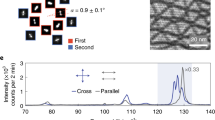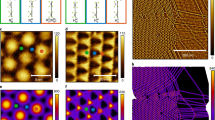Abstract
Moiré superlattices in van der Waals structures can be used to control the electronic properties of the material and can lead to emergent correlated and topological phenomena. Non-collinear states and domain structures have previously been observed in twisted van der Waals magnets, but the effective manipulation of the magnetic behaviour remains challenging. Here we report electrically tunable moiré magnetism in twisted double bilayers—that is, a bilayer plus a bilayer with a twist angle between them—of layered antiferromagnet chromium triiodide. Using magneto-optical Kerr effect microscopy, we observe the coexistence of antiferromagnetic and ferromagnetic order with non-zero net magnetization—a hallmark of moiré magnetism. Such a magnetic state extends over a wide range of twist angles (with transitions at around 0° and above 20°) and exhibits a non-monotonic temperature dependence. We also demonstrate voltage-assisted magnetic switching. The observed non-trivial magnetic states, as well as control via twist angle, temperature and electrical gating, are supported by a simulated phase diagram of moiré magnetism.
This is a preview of subscription content, access via your institution
Access options
Access Nature and 54 other Nature Portfolio journals
Get Nature+, our best-value online-access subscription
$29.99 / 30 days
cancel any time
Subscribe to this journal
Receive 12 digital issues and online access to articles
$119.00 per year
only $9.92 per issue
Buy this article
- Purchase on Springer Link
- Instant access to full article PDF
Prices may be subject to local taxes which are calculated during checkout





Similar content being viewed by others
Data availability
The data that support the findings of this study are available from the corresponding authors upon reasonable request.
Code availability
The computer code used in this study is available from the corresponding authors upon reasonable request.
References
Cao, Y. et al. Correlated insulator behaviour at half-filling in magic-angle graphene superlattices. Nature 556, 80–84 (2018).
Cao, Y. et al. Unconventional superconductivity in magic-angle graphene superlattices. Nature 556, 43–50 (2018).
Jin, C. et al. Observation of moiré excitons in WSe2/WS2 heterostructure superlattices. Nature 567, 76–80 (2019).
Chen, G. et al. Evidence of a gate-tunable Mott insulator in a trilayer graphene moiré superlattice. Nat. Phys. 15, 237–241 (2019).
Hunt, B. et al. Massive Dirac fermions and Hofstadter butterfly in a van der Waals heterostructure. Science 340, 1427–1430 (2013).
Sharpe, A. L. et al. Emergent ferromagnetism near three-quarters filling in twisted bilayer graphene. Science 365, 605–608 (2019).
Sunku, S. S. et al. Photonic crystals for nano-light in moiré graphene superlattices. Science 362, 1153–1156 (2018).
Chen, X. et al. Moiré engineering of electronic phenomena in correlated oxides. Nat. Phys. 16, 631–635 (2020).
Hu, G. et al. Topological polaritons and photonic magic angles in twisted α-MoO3 bilayers. Nature 582, 209–213 (2020).
Song, T. et al. Direct visualization of magnetic domains and moiré magnetism in twisted 2D magnets. Science 374, 1140–1144 (2021).
Xu, Y. et al. Coexisting ferromagnetic–antiferromagnetic state in twisted bilayer CrI3. Nat. Nanotechnol. 17, 143–147 (2021).
Xie, H. et al. Twist engineering of the two-dimensional magnetism in double bilayer chromium triiodide homostructures. Nat. Phys. 18, 30–36 (2021).
Cao, Y. et al. Superlattice-induced insulating states and valley-protected orbits in twisted bilayer graphene. Phys. Rev. Lett. 117, 116804 (2016).
Burch, K. S., Mandrus, D. & Park, J. G. Magnetism in two-dimensional van der Waals materials. Nature 563, 47–52 (2018).
Banerjee, A. et al. Neutron scattering in the proximate quantum spin liquid α-RuCl3. Science 356, 1055–1058 (2017).
Gibertini, M., Koperski, M., Morpurgo, A. F. & Novoselov, K. S. Magnetic 2D materials and heterostructures. Nat. Nanotechnol. 14, 408–419 (2019).
Jiang, S. W., Shan, J. & Mak, K. F. Electric-field switching of two-dimensional van der Waals magnets. Nat. Mater. 17, 406–410 (2018).
Li, T. X. et al. Pressure-controlled interlayer magnetism in atomically thin CrI3. Nat. Mater. 18, 1303–1308 (2019).
Deng, Y. et al. Gate-tunable room-temperature ferromagnetism in two-dimensional Fe3GeTe2. Nature 563, 94–99 (2018).
Gong, C. et al. Discovery of intrinsic ferromagnetism in two-dimensional van der Waals crystals. Nature 546, 265–269 (2017).
Hejazi, K., Luo, Z. X. & Balents, L. Noncollinear phases in moiré magnets. Proc. Natl Acad. Sci. USA 117, 10721–10726 (2020).
Tong, Q. J., Liu, F., Xiao, J. & Yao, W. Skyrmions in the moiré of van der Waals 2D magnets. Nano Lett. 18, 7194–7199 (2018).
Wang, C., Gao, Y., Lv, H. Y., Xu, X. D. & Xiao, D. Stacking domain wall magnons in twisted van der Waals magnets. Phys. Rev. Lett. 125, 247201 (2020).
Akram, M. et al. Moiré skyrmions and chiral magnetic phases in twisted CrX3 (X = I, Br, and Cl) bilayers. Nano Lett. 21, 6633–6639 (2021).
Sivadas, N., Okamoto, S., Xu, X. D., Fennie, C. J. & Xiao, D. Stacking-dependent magnetism in bilayer CrI3. Nano Lett. 18, 7658–7664 (2018).
Wang, W.-G., Li, M., Hageman, S. & Chien, C. L. Electric-field-assisted switching in magnetic tunnel junctions. Nat. Mater. 11, 64–68 (2012).
Jiang, S. W., Li, L. Z., Wang, Z. F., Mak, K. F. & Shan, J. Controlling magnetism in 2D CrI3 by electrostatic doping. Nat. Nanotechnol. 13, 549–553 (2018).
Kim, K. et al. Van der Waals heterostructures with high accuracy rotational alignment. Nano Lett. 16, 1989–1995 (2016).
Wu, M., Li, Z. L., Cao, T. & Louie, S. G. Physical origin of giant excitonic and magneto-optical responses in two-dimensional ferromagnetic insulators. Nat. Commun. 10, 2371 (2019).
Andrei, E. Y. & MacDonald, A. H. Graphene bilayers with a twist. Nat. Mater. 19, 1265–1275 (2020).
Huang, B. et al. Layer-dependent ferromagnetism in a van der Waals crystal down to the monolayer limit. Nature 546, 270–273 (2017).
Song, T. C. et al. Giant tunneling magnetoresistance in spin-filter van der Waals heterostructures. Science 360, 1214–1218 (2018).
Xie, H. et al. Evidence of non-collinear spin texture in magnetic moiré superlattices. Nat. Phys. https://doi.org/10.1038/s41567-023-02061-z (2023).
Sun, Q. C. et al. Magnetic domains and domain wall pinning in atomically thin CrBr3 revealed by nanoscale imaging. Nat. Commun. 12, 1989 (2021).
Kohlhepp, J., Elmers, H. J., Cordes, S. & Gradmann, U. Power laws of magnetization in ferromagnetic monolayers and the two-dimensional Ising model. Phys. Rev. B 45, 12287–12291 (1992).
Kim, M. et al. Micromagnetometry of two-dimensional ferromagnets. Nat. Electron. 2, 457–463 (2019).
Huang, B. et al. Electrical control of 2D magnetism in bilayer CrI3. Nat. Nanotechnol. 13, 544–548 (2018).
Chiba, D., Yamanouchi, M., Matsukura, F. & Ohno, H. Electrical manipulation of magnetization reversal in a ferromagnetic semiconductor. Science 301, 943–945 (2003).
Sivadas, N., Okamoto, S. & Xiao, D. Gate-controllable magneto-optic Kerr effect in layered collinear antiferromagnets. Phys. Rev. Lett. 117, 267203 (2016).
Lei, C. et al. Magnetoelectric response of antiferromagnetic CrI3 bilayers. Nano Lett. 21, 1948–1954 (2021).
Lado, J. L. & Fernández-Rossier, J. On the origin of magnetic anisotropy in two dimensional CrI3. 2D Mater. 4, 035002 (2017).
Rustagi, A., Solanki, A. B., Tserkovnyak, Y. & Upadhyaya, P. Coupled spin-charge dynamics in magnetic van der Waals heterostructures. Phys. Rev. B 102, 094421 (2020).
Du, C. et al. Control and local measurement of the spin chemical potential in a magnetic insulator. Science 357, 195–198 (2017).
Yoo, H. et al. Atomic and electronic reconstruction at the van der Waals interface in twisted bilayer graphene. Nat. Mater. 18, 448–453 (2019).
Gong, C. & Zhang, X. Two-dimensional magnetic crystals and emergent heterostructure devices. Science 363, eaav4450 (2019).
Liu, Y. & Petrovic, C. Three-dimensional magnetic critical behavior in CrI3. Phys. Rev. B 97, 014420 (2018).
Idzuchi, H. L., Allcca, A. E., Pan, X. C., Tanigaki, K. & Chen, Y. P. Increased Curie temperature and enhanced perpendicular magneto anisotropy of Cr2Ge2Te6/NiO heterostructures. Appl. Phys. Lett. 115, 232403 (2019).
Cai, X. et al. Atomically thin CrCl3: an in-plane layered antiferromagnetic insulator. Nano Lett. 19, 3993–3998 (2019).
Acknowledgements
We acknowledge partial support of the work from the US Department of Energy (DOE), Office of Science, through the Quantum Science Center (QSC, a National Quantum Information Science Research Center) and Department of Defense (DOD) Multidisciplinary University Research Initiatives (MURI) program (FA9550-20-1-0322) for materials and device fabrication and the MOKE and TEM measurements. G.C. and Y.P.C. also acknowledge partial support from WPI-AIMR, JSPS KAKENHI Basic Science A (18H03858), New Science (18H04473 and 20H04623) and Tohoku University FRiDUO program in early stages of the research. M.M.R., A.R. and P.U. also acknowledge support from the National Science Foundation (NSF) (ECCS-1810494). Z.M. acknowledges support from the US DOE under grant DE-SC0019068 for sample synthesis. K.W. and T.T. acknowledge support from the JSPS KAKENHI (grant numbers 20H00354, 21H05233 and 23H02052) and World Premier International Research Center Initiative (WPI), MEXT, Japan.
Author information
Authors and Affiliations
Contributions
G.C. and Y.P.C. conceived the project. G.C. fabricated the devices and performed the experiments, assisted by A.L.A. M.M.R., A.R. and P.U. performed the supporting theoretical analysis. X.L., G.C., L.L. and L.F. performed the TEM measurements. Y.Z. and Z.M. provided the bulk CrI3 crystals. K.W. and T.T. provided the bulk hBN crystals. Y.P.C. and P.U. supervised the project. G.C., M.M.R., P.U. and Y.P.C. wrote the manuscript with input from all co-authors.
Corresponding authors
Ethics declarations
Competing interests
The authors declare no competing interests.
Peer review
Peer review information
Nature Electronics thanks the anonymous reviewers for their contribution to the peer review of this work.
Additional information
Publisher’s note Springer Nature remains neutral with regard to jurisdictional claims in published maps and institutional affiliations.
Supplementary information
Supplementary Information
Supplementary Notes 1–13 and Figs. 1–17.
Rights and permissions
Springer Nature or its licensor (e.g. a society or other partner) holds exclusive rights to this article under a publishing agreement with the author(s) or other rightsholder(s); author self-archiving of the accepted manuscript version of this article is solely governed by the terms of such publishing agreement and applicable law.
About this article
Cite this article
Cheng, G., Rahman, M.M., Allcca, A.L. et al. Electrically tunable moiré magnetism in twisted double bilayers of chromium triiodide. Nat Electron 6, 434–442 (2023). https://doi.org/10.1038/s41928-023-00978-0
Received:
Accepted:
Published:
Issue Date:
DOI: https://doi.org/10.1038/s41928-023-00978-0
This article is cited by
-
Beyond moiré in twisted two-dimensional magnets
Nature Materials (2024)
-
Revealing intrinsic domains and fluctuations of moiré magnetism by a wide-field quantum microscope
Nature Communications (2023)



